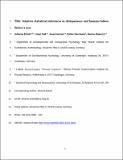Files in this item
Intuitive statistical inferences in chimpanzees and humans follow Weber‘s Law
Item metadata
| dc.contributor.author | Eckert, Johanna | |
| dc.contributor.author | Call, Josep | |
| dc.contributor.author | Hermes, Jonas | |
| dc.contributor.author | Herrmann, Esther | |
| dc.contributor.author | Rakoczy, Hannes | |
| dc.date.accessioned | 2019-07-13T23:41:28Z | |
| dc.date.available | 2019-07-13T23:41:28Z | |
| dc.date.issued | 2018-11 | |
| dc.identifier | 254028431 | |
| dc.identifier | dc59052e-c95b-4b69-9325-e4872de66238 | |
| dc.identifier | 85049793503 | |
| dc.identifier | 000446284000009 | |
| dc.identifier.citation | Eckert , J , Call , J , Hermes , J , Herrmann , E & Rakoczy , H 2018 , ' Intuitive statistical inferences in chimpanzees and humans follow Weber‘s Law ' , Cognition , vol. 180 , pp. 99-107 . https://doi.org/10.1016/j.cognition.2018.07.004 | en |
| dc.identifier.issn | 0010-0277 | |
| dc.identifier.other | ORCID: /0000-0002-8597-8336/work/46761186 | |
| dc.identifier.uri | https://hdl.handle.net/10023/18096 | |
| dc.description | This work was supported by a research grant of the German Science Foundation DFG (grant # RA 2155/3-1) to Hannes Rakoczy and Josep Call. | en |
| dc.description.abstract | Humans and nonhuman great apes share a sense for intuitive statistical reasoning, making intuitive probability judgments based on proportional information. This ability is of fundamental importance, in particular for inferring general regularities from finite numbers of observations and, vice versa, for predicting the outcome of single events using prior information. To date it remains unclear which cognitive mechanism underlies and enables this capacity. The aim of the present study was to gain deeper insights into the cognitive structure of intuitive statistics by probing its signatures in chimpanzees and humans. We tested 24 sanctuary-living chimpanzees in a previously established paradigm which required them to reason from populations of food items with different ratios of preferred (peanuts) and non-preferred items (carrot pieces) to randomly drawn samples. In a series of eight test conditions, the ratio between the two ratios to be discriminated (ROR) was systematically varied ranging from 1 (same proportions in both populations) to 16 (high magnitude of difference between populations). One hundred and forty-four human adults were tested in a computerized version of the same task. The main result was that both chimpanzee and human performance varied as a function of the log(ROR) and thus followed Weber´s law. This suggests that intuitive statistical reasoning relies on the same cognitive mechanism that is used for comparing absolute quantities, namely the analogue magnitude system. | |
| dc.format.extent | 9 | |
| dc.format.extent | 805394 | |
| dc.language.iso | eng | |
| dc.relation.ispartof | Cognition | en |
| dc.subject | Probabilistic reasoning | en |
| dc.subject | Numerical cognition | en |
| dc.subject | Analogue magnitude system | en |
| dc.subject | Signature limits | en |
| dc.subject | Great apes | en |
| dc.subject | Sanctuary-living | en |
| dc.subject | BF Psychology | en |
| dc.subject | QA Mathematics | en |
| dc.subject | RC0321 Neuroscience. Biological psychiatry. Neuropsychiatry | en |
| dc.subject | DAS | en |
| dc.subject.lcc | BF | en |
| dc.subject.lcc | QA | en |
| dc.subject.lcc | RC0321 | en |
| dc.title | Intuitive statistical inferences in chimpanzees and humans follow Weber‘s Law | en |
| dc.type | Journal article | en |
| dc.contributor.institution | University of St Andrews. Centre for Social Learning & Cognitive Evolution | en |
| dc.contributor.institution | University of St Andrews. School of Psychology and Neuroscience | en |
| dc.identifier.doi | https://doi.org/10.1016/j.cognition.2018.07.004 | |
| dc.description.status | Peer reviewed | en |
| dc.date.embargoedUntil | 2019-07-14 |
This item appears in the following Collection(s)
Items in the St Andrews Research Repository are protected by copyright, with all rights reserved, unless otherwise indicated.

